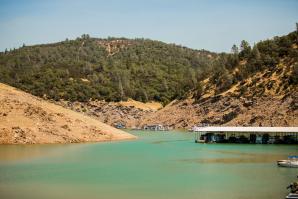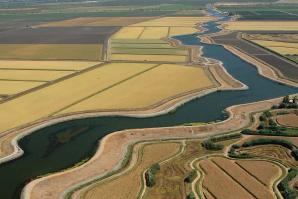Jessica Law became executive director of the Water Forum in January. In 1993, the City and County of Sacramento launched negotiations to figure out how to ensure reliable water supplies and safeguard the environmental needs of the Lower American River. In 2000, 40 different agencies signed the Water Forum Agreement, which has guided the organization’s work ever since.
Law, who grew up in Miami, Florida, has a bachelor’s degree in biology from Connecticut College and a master’s degree in regional planning from the University of Massachusetts, Amherst. She came to the Water Forum with more than 15 years of experience in water and environmental resource management, public process and land-use planning.
You came to this position from working as chief deputy executive officer of the Delta Stewardship Council. How does that work translate to your job now?
I’ve been living in Sacramento going on 15 years now. For the majority of my career, I’ve been working on water and environmental issues and really working on a lot of these very complex environmental projects, everything from high-speed rail to the (Bay) Delta Conservation Plan to the work that I was doing at the Delta Stewardship Council, which was really helping to support ecosystem restoration in the (Sacramento-San Joaquin) Delta, along with a whole host of other projects. Regardless of position, I’ve been really focused on policy and strategy and how you improve conditions … throughout the state to support stronger resource management and really support the natural resources of the state.
Through all of this work, there’s policy and there’s strategy, and then there’s the art of decision-making. This work is not all facts and figures. A lot of this work is about relationships and building trust. … I’ve done a tremendous amount of work in facilitation and conflict resolution. I’ve found that that is really the space where these decisions are made — groups of people coming together to collaborate, to communicate, to show up and to really be able to share where their interests and their positions are and to work toward common goals. I’ve been practicing that for the past 15 years, trying to reach common ground on really, really complex environmental issues, and the Water Forum has such a unique history of working together to bring diverse voices to the table.
What does this year’s drought mean for the Water Forum in terms of the work you’re doing or any shifting priorities for the organization?
I’ve been impressed with just the tremendous amount of institutional knowledge within this group about how we dealt with the last drought. But let me explain a little bit more about the Water Forum and our role during this drought in particular. The Water Forum Agreement outlines actions that water districts need to take during the drought to cut back on diversions from the river.
Our objective is to work with the Bureau of Reclamation — they are the ones that manage Folsom Reservoir — to see how they can keep enough water in Folsom that would protect fish in the river. The reason that’s important is because you want to make sure there’s enough cold water to keep water temperatures in the river at tolerable conditions or better for the fish, and also to really make sure we have sufficient water supply not just this year but also going into next year.
We provide technical support and modeling to support decision-making by the state and federal agencies. These include the Bureau of Reclamation, State Water Resources Control Board, Department of Water Resources, National Marine Fisheries Service, California Department of Fish and Wildlife. We come together as agencies and partners and stakeholders to think through these decisions and it really is a very collaborative process.
If you asked me this question in February, what this year was going to look like, I would have said that we were cautiously optimistic, because we had pretty good snowpack levels, but that snow didn’t show up. It didn’t show up in Folsom, it didn’t show up in lakes and reservoirs upstream. … We are working very carefully now to fine-tune the information we have and to help plan for this year and beyond.
Snowpack levels not showing up in the reservoirs and Folsom Lake — what does that mean exactly?
It means that instead of being runoff — instead of melting and flowing downhill — it was absorbed into the groundwater or sublimated. We got some really cold storms this year. I am not a meteorologist, so my understanding is we got really cold storms this year, the ground was dry when snow hit it, and so as the snow was melting, it was absorbed into the ground. Imagine a really dry sponge; you put ice cubes on top, it’s going to get absorbed in, as opposed to if your ground is wet already and then you’ve got snow on top, it would run off. Part of this is just an indication overall of how dry conditions are throughout the West. Soil is really dry.
Back in February, as you said, you would have been cautiously optimistic. What’s your outlook now for this water year?
As we go through the year, we’re understanding more and more about the conditions right now. So June, we know that it’s worse than it was in (the historic drought of) 2014-2015, this time of year. If you go out to Folsom and look at lake levels, they’re at around 360,000 acre-feet. We know those levels are going to be dropping to about 200,000 acre-feet by the end of September, and that is a management goal we have in common with the federal agencies and state agencies. We know it’s going to be dropping, but that is what we’re aiming for in terms of best management for this year in really challenging conditions.
I’d say we are doing a lot to understand and fine-tune the information coming in to make sure we have accurate models and accurate forecasting as much as possible about water that will be coming into Folsom — those inflow projections. We know that the situation we’re looking at, it’s getting worse. So it’s a really dire year. Everyone really needs to be doing what they can to make it better.
We’ve been working with the Bureau of Reclamation to carefully manage this remaining storage that’s in Folsom, and we really have a common goal and a common target. … They need to be doing everything that they can to keep us at 200,000 acre-feet, but that’s also on the Water Forum and our members to be doing everything we can through conservation, through moving water around, through switching diversions from the American River to the Sacramento River, which is a bigger river, higher volume. That’s the flexibility that the City of Sacramento has.
We know that the situation we’re looking at, it’s getting worse. So it’s a really dire year. Everyone really needs to be doing what they can to make it better.
We’re also doing a lot to switch to groundwater. The Water Forum Agreement anticipated this, when we put it together 20 years ago, that there would be drought conditions. There (are) a set of actions outlined in the Water Forum agreement that we’re implementing this year to make sure we can create reliability and really improve conditions for fish. In terms of achieving this goal, by getting to 200,000 acre-feet by the end of September (and) working towards these common goals, we’re hoping to help steelhead salmon and fall-run chinook that are in the river. We’re hoping to put this region in a better position to withstand continued dry conditions. I can’t emphasize enough that everyone’s got a role to play. …
Thinking about those lake levels, talking about 200,000 acre-feet and 230,000 acre-feet by the end of December … based on our experience in the last drought, we know those numbers are important to aim for going into the next year in case a drought continues. We also know that as lake levels go lower, the water gets warmer. … We know we’re going to be seeing temperatures that are anywhere from 6-8 degrees above where they have been in the past for that median level. These are pretty terrible temperatures for fish, so it’s not instantaneously lethal, but we know we’re going to see a lot more disease and higher mortality.
You mentioned how it’s critical that everyone does their part. With the last drought, did we do our part?
Yes, actually this region … did really well in terms of conservation. … Right now, most of the Western states are in the grip of a severe drought of historic proportions. Conditions are really dire. So it’s not just us. This is throughout the West. This year is really a case study about climate change. It’s important for us to be prepared, not just within this region, but within the West, for extremes like flood, fire and drought.
We are still preparing for floods, and there’s still a lot of work that’s going into that and that’s important work, but climate change is happening and it’s impacting our lives now. We can see it, we can smell it, we can feel it, there’s gonna be more wildfires. … The wildfires now are different than they have been in the past, they’re burning hotter and they’re burning faster. We’re having hotter summers that have more days of over 100 degrees.
Most of the Western states are in the grip of a severe drought of historic proportions. Conditions are really dire. So it’s not just us. This is throughout the West. This year is really a case study about climate change.
Drought is really a constant concern for this region. This region gets most of its precipitation in a few big storms over the winter months. This year, we saw even a few variations, just slight variations: It’s too windy, it’s too wet, it’s too cold. The characteristics of those storms really drastically change what the rest of the year looks like. Hopefully, we don’t need more years like this for the region and for residents of this region to recognize that humans are drastically altering the planet at a really fundamental level and that we need to take action to reverse these trends within our lifetime.
We have so much new home building going on in this region — in Folsom, in Rancho Cordova, in Roseville. How can we accommodate all these new homes and still manage our water supply?
Oh, that’s such a good question. In terms of the Water Forum’s work, we are very interested in what the water demands are for the region. There’s a whole round of urban water management plans that are coming out this year. These are required reports the water purveyors have to provide to the state every five years that look at demand overall. …
When we look at that, we’re taking that information, along with other information about how this region is growing, and thinking about how that connects to our longer term work of the Water Forum. So talking a little bit about the Water Forum 2.0 process, the original Water Forum Agreement, it took them seven years to put it together. It was just an outstanding example of how to do interest-based negotiation and get to an agreement, and that agreement has been in place for 20 years.
We’ve got another 10 years of the existing agreement, but things move fast. We have been working over the last year and we’ll have another year of work to do to renegotiate that agreement and to put in place these protections that will really help the region over the next 20-30 years.
Being able to meet the demand for affordable housing is critical — a part of that is you can’t build unless you’ve got water supply.
One of the biggest things we’re looking at is climate change and how that is going to be impacting the region, and specifically, what’s the probability that we’re going to have more drought years? Will we be able to meet the water supply needs of the region going forward? Will we be able to meet housing demand? Affordable housing is an incredibly important issue, especially in California and especially now. So being able to meet the demand for affordable housing is critical — a part of that is you can’t build unless you’ve got water supply. That’s an integral part of regulation and how land-use planning works in the region.
There’s a few things to know about new housing developments. Yes, there are new housing developments, and we need to make sure there are water supplies to meet those new demands. New housing developments tend to be … much more efficient in terms of water use than existing homes.
I live in a house built in 1951. We’ve done a lot here to improve our irrigation systems, make sure we’re on drip irrigation, upgrade our showerheads, upgrade the toilets, make sure we have water-efficient appliances and we’re reducing our water use. That’s much more of a challenge in older homes than it is in newer homes; people are walking into them and there’s already low-flow toilets, there’s already showerheads that are efficient, there’s already drip irrigation. The landscaping isn’t acres of grass; it’s low-use water plants and landscaping.
The other piece of that is as a region, we’re still growing, but the demand numbers are actually coming down. There’s some really interesting work that’s been done by … the Sacramento Area Council of Governments, the regional planning authority, they did something called the Blueprint around 2000 and looked at buildout capacity of the region. … They’re realizing that the buildout numbers and the rate of growth and development in this region is slowing. I think that’s OK. We need to continue to provide affordable housing. We need to make sure our water supplies are meeting our demand and we need to make sure we’re increasing residential water-use efficiency.
In August and September, the Water Forum is doing a habitat restoration project on the Lower American River by Ancil Hoffman Park. What’s the significance of that project?
This habitat program restores fish spawning gravel beds, and helps improve juvenile fish rearing habitat on the Lower American River. When fish are spawning in the fall, you can go out and see the little tails and their little fins and they look really busy in the gravel. Well, we are placing more gravel in the river to support the creation of these salmon nests where they lay the eggs, the eggs are fertilized and that’s their nest. This is our 10th habitat restoration project. In the past, the Lower American River has been a prime area for salmon and steelhead spawning. That area has degraded over time, whether it’s resulting from mining activities, dams (or) just encroachment on a very wild and scenic river. We’re looking to restore that.
You’ve talked about Water Forum 2.0 a little bit. Did you want to talk more about that?
This is one of my favorite things to talk about. … We’re focusing on habitat enhancement and habitat management. The Water Forum has a long history of doing habitat restoration work in the river. We’re going to continue that (and) continue to look at other opportunities … to support salmon species. … We’re continuing to improve our science program and our monitoring modeling work that really goes into some of the decisions about flows and operations and temperature management — all the stuff that’s super important this year in the drought.
A really important topic for the Water Forum: 20 years ago, topics of groundwater and surface water were kind of separate. When the Water Forum Agreement was put into place in 2000, it identified groundwater sustainability as being really critical to the region’s reliability. In fact, the Sacramento Groundwater Authority, which resulted from the Water Forum negotiations, really served as a model for this region, prior to SGMA being put in place, the Sustainable Groundwater Management Act (of 2014).
Unlike other regions of the state, our region’s groundwater supplies are sustainable thanks to 20 years of careful management. That’s our backdrop for this year and going forward even more so. I think we’re in a really good position here to rely on groundwater supplies. In Water Forum 2.0, we know we need to do more. We’re looking at climate change in a really detailed way.
Unlike other regions of the state, our region’s groundwater supplies are sustainable thanks to 20 years of careful management. That’s our backdrop for this year and going forward even more so.
The Regional Water Authority is planning already to expand its ability to manage groundwater and surface water, according to availability, through something called a groundwater bank. The long-term vision is to support the groundwater bank that would be able to provide flexibility to this region. There’s some of this in place already, but it’s a way to coordinate how we manage water and water supply, whether it’s coming from a river or it’s coming from underground aquifers.
You think about the Sierra and imagine in January when they’re covered in snow, and you look a little bit downhill from that and imagine there’s this huge sort of stretch of land … that’s really this aquifer that can hold groundwater. The Regional Water Authority has plans in place to expand the system of wells that allow us to pump groundwater in dry years, and that’s just a much larger, more vast bank of water than imagining Folsom Reservoir, which is really sort of a dot on the map, compared to that snowpack and that aquifer.
It’s a way of managing in the 21st century, and if climate change is showing us anything, it’s showing us that the things we’ve done in the past are not going to work going into the future. We need to be smarter, we need to be more thoughtful, we need to be managing based on how ecosystems work, not how pipes and plumbing works.
We’re really hoping to outline what those actions are, what top-priority projects are, and what the region has to support in order to reach sustainability and create reliability for this region going forward. The (other) component of Water Forum 2.0 is stewardship. … We’re thinking hard about what we want our legacy to continue to be moving forward, how do we want to be stewards of the Lower American River and Folsom.
Edited for length and clarity.
–
Stay up to date on business in the Capital Region: Subscribe to the Comstock’s newsletter today.
Recommended For You

Facing ‘Dire Water Shortages,’ California Bans Delta Pumping
Growers’ groups voiced strong opposition, questioning the water board’s power to stop senior rights holders from pumping the water.

Keeping the Water Flowing
The Fair Oaks Water District finds new ways to serve customers during the pandemic
COVID-19 is threatening the financial stability of water suppliers providing an essential public health service. Water utilities are faced with an extraordinary combination of increasing costs to meet needs and falling revenues resulting from declining commercial use and personal financial strain on ratepayers.

Delta Blues
The battle over water has been fought to a standstill, but there’s hope that science and technology will make voluntary agreements by all sides possible
For decades, the California water debate revolved around one metric: unimpeded flow, which is the amount of water in the river and streams. While flow is still without doubt the key issue, it is no longer the only one.

Going With the Flows
McGeorge School of Law professor Jennifer Harder on water issues, laws and uses
Professor Jennifer Harder is the co-director of the Water & Environmental Law program at McGeorge School of Law in Sacramento. Comstock’s spoke with Harder about water issues affecting the Capital Region and California.





Comments
For decades we have known there would be periods of drought throughout the west and that existing water storage facilities were being tested to their limits. Yet, as I understand, two proposed storage reservoirs were turned down because of protests from kayakers and environmental groups; I'm sure there were other reasons too. As CA grows wouldn't you think these two proposed storage facilities and the resulting pristine lakes would help us to keep up with water demand?